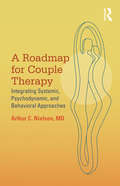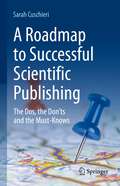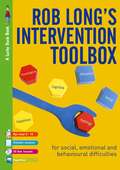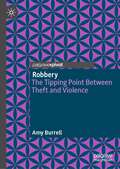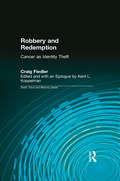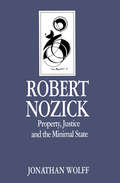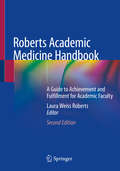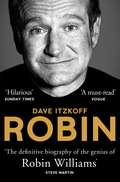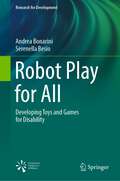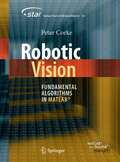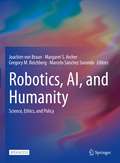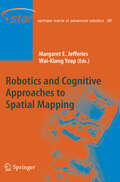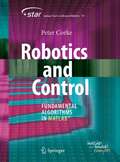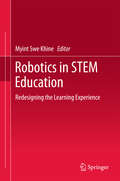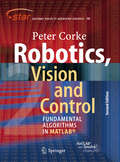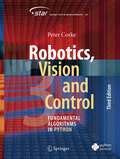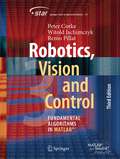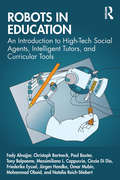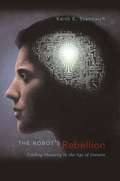- Table View
- List View
A Roadmap for Couple Therapy: Integrating Systemic, Psychodynamic, and Behavioral Approaches
by Arthur C. NielsenA Roadmap for Couple Therapy offers a comprehensive, flexible, and user-friendly template for conducting couple therapy. Grounded in an in-depth review of the clinical and research literature, and drawing on the author’s 40-plus years of experience, it describes the three main approaches to conceptualizing couple distress and treatment—systemic, psychodynamic, and behavioral—and shows how they can be integrated into a model that draws on the best of each. Unlike multi-authored texts in which each chapter presents a distinct brand of couple therapy, this book simultaneously engages multiple viewpoints and synthesizes them into a coherent model. Covering fundamentals and advanced techniques, it speaks to both beginning therapists and experienced clinicians. Therapists will find A Roadmap for Couple Therapy an invaluable resource as they help distressed couples repair and revitalize their relationships.
A Roadmap for Couple Therapy: Integrating Systemic, Psychodynamic, and Behavioral Approaches
by Arthur C. NielsenA Roadmap for Couple Therapy offers a comprehensive, flexible, and user-friendly template for conducting couple therapy. Grounded in an in-depth review of the clinical and research literature, and drawing on the author’s 40-plus years of experience, it describes the three main approaches to conceptualizing couple distress and treatment—systemic, psychodynamic, and behavioral—and shows how they can be integrated into a model that draws on the best of each. Unlike multi-authored texts in which each chapter presents a distinct brand of couple therapy, this book simultaneously engages multiple viewpoints and synthesizes them into a coherent model. Covering fundamentals and advanced techniques, it speaks to both beginning therapists and experienced clinicians. Therapists will find A Roadmap for Couple Therapy an invaluable resource as they help distressed couples repair and revitalize their relationships.
A Roadmap to Successful Scientific Publishing: The Dos, the Don’ts and the Must-Knows
by Sarah CuschieriIn the age of "publish or perish," this book provides everything one needs to know about conducting research and successfully publishing it in a scientific journal. The reader learns about the complete process of scientific publishing: from selecting the most appropriate research design, to obtaining permissions and funding, to resourcefully presenting the research results in a poster and oral presentation. Additionally, the practical tips provided here help the reader formulate a compelling scientific article and choose the most suitable journal (subscription vs. the various open access modalities) for their publication.This book also addresses "invisible aspects" of scholarly publishing that are nonetheless important and that everyone should know and understand: avoiding predatory journals, understanding the editor's perspective, and becoming familiar with the various research metrics (from author to journal) that can all determine success or failure of a publication. Written in an informal style in which the author shares personal perspectives and experiences, the book is easily accessible to the reader. The book offers early career scientists in biomedicine and medicine a unique perspective on publishing research articles and how this process can enhance the authors' "scientific value" within the scientific ecosystem as well as their personal CVs.
Rob Long's Intervention Toolbox: For Social, Emotional and Behavioural Difficulties (PDF)
by Rob Long'Rob Long's expertise is evident in every compartment of this 'toolbox'. His finely honed approach to social, emotional and behavioural difficulties will be of equal use to leadership teams setting policy as to the classroom teacher requiring insight on challenging behaviour. As with any toolbox, this book is a must to have to hand!' - Jan Baker - Primary Headteacher Rob Long's Intervention Toolbox is written for education practitioners who support young people with problem behaviours that act as barriers to their successful engagement with school. Taking a multi-dimensional approach, the Toolbox provides solutions to deal with the multi-faceted nature of challenging behaviour. There are 6 compartments to the Toolbox: - Physiological - Feelings - Behaviour - Cognitive - Social - Happiness. For each compartment there are a number of tools (interventions) that may be used depending on the age and level of understanding of the young person. As all problem behaviours have many component parts, the Toolbox enables practitioners to employ several interventions to comprehensively tackle challenging behaviours. There are specific sections on both Asperger's Syndrome and Attention Deficit Hyperactivity Disorders with In Class Behaviour Plans for these learners, as well as an accompanying CD Rom including resources for putting strategies into practice. The CD Rom also provides PowerPoint slides for training staff in using the Toolbox. As an experienced professional, teacher and educational psychologist, Rob Long's strategies combine innovation with sound psychology and learning theories.
Robbery: The Tipping Point Between Theft and Violence
by Amy BurrellThis book brings together research on personal robbery from psychology, criminology, group dynamics, and youth justice, to provide a comprehensive resource on this crime type. Although robbery is a pressing issue affecting a very high volume of people, it has been under-researched in recent years. This book explores the motivations of offenders, methods of committing personal robbery and the group dynamics involved. The author discusses behavioural crime linkage as a method to help police forces identify serial offences, as well as how profiling has been used in robbery cases. The author concludes by summarising the policing tactics used to prevent and detect robbery, to show how understanding robbery can help in creating workable initiatives around this crime type.
Robbery and Redemption: Cancer as Identity Theft (Death, Value and Meaning Series)
by Craig Fiedler Kent L KoppelmanFirst Published in 2017. This volume is a totally candid account about the facts and feelings surrounding the diagnosis of and battle against lung cancer—a battle the author waged with every ounce of his being. It has an enlightening quality because he shares how he transformed his previous knowledge of family dynamics, coping strategies, and empowerment into wisdom. He shares his journey of taking the knowledge from the Before Cancer phase of his life, “and like an alchemist, converting one raw material—his life and his diagnosis and battle—into an element quite unlike the original. Robbery and Redemption: Cancer as Identity Theft is chock-full of wisdom that has been learned the old fashioned, visceral way—from lived experience and keen reflection. This personal, upfront, “rubber-hit-the-road” treatise is a gift from the author to each reader. It is his wise interpretation of his own experiences of integrating values, problem solving, and coping strategies.
Robbery and Redemption: Cancer as Identity Theft (Death, Value and Meaning Series)
by Craig Fiedler Kent L KoppelmanFirst Published in 2017. This volume is a totally candid account about the facts and feelings surrounding the diagnosis of and battle against lung cancer—a battle the author waged with every ounce of his being. It has an enlightening quality because he shares how he transformed his previous knowledge of family dynamics, coping strategies, and empowerment into wisdom. He shares his journey of taking the knowledge from the Before Cancer phase of his life, “and like an alchemist, converting one raw material—his life and his diagnosis and battle—into an element quite unlike the original. Robbery and Redemption: Cancer as Identity Theft is chock-full of wisdom that has been learned the old fashioned, visceral way—from lived experience and keen reflection. This personal, upfront, “rubber-hit-the-road” treatise is a gift from the author to each reader. It is his wise interpretation of his own experiences of integrating values, problem solving, and coping strategies.
Robert Nozick: Property, Justice and the Minimal State (Key Contemporary Thinkers)
by Jonathan WolffRobert Nozick's Anarchy, State and Utopia is one of the works which dominates contemporary debate in political philosophy. Drawing on traditional assumptions associated with individualism and libertarianism, Nozick mounts a powerful argument for a minimal `nightwatchman' state and challenges the views of many contemporary philosophers, most notably John Rawls. Jonathan Wolff's new book is the first full-length study of Nozick's work and of the debates to which it has given rise. He situates Nozick's work in the context of current debates and examines the traditions which have influenced his thought. He then critically reconstructs the key arguments of Anarchy, State and Utopia, focusing on Nozick's Doctrine of Rights, his Derivation of the Minimal State, and his Entitlement Theory of Justice. The book concludes by assessing Nozick's place in contemporary political philosophy.
Robert Nozick: Property, Justice and the Minimal State (Key Contemporary Thinkers)
by Jonathan WolffRobert Nozick's Anarchy, State and Utopia is one of the works which dominates contemporary debate in political philosophy. Drawing on traditional assumptions associated with individualism and libertarianism, Nozick mounts a powerful argument for a minimal `nightwatchman' state and challenges the views of many contemporary philosophers, most notably John Rawls. Jonathan Wolff's new book is the first full-length study of Nozick's work and of the debates to which it has given rise. He situates Nozick's work in the context of current debates and examines the traditions which have influenced his thought. He then critically reconstructs the key arguments of Anarchy, State and Utopia, focusing on Nozick's Doctrine of Rights, his Derivation of the Minimal State, and his Entitlement Theory of Justice. The book concludes by assessing Nozick's place in contemporary political philosophy.
Roberts Academic Medicine Handbook: A Guide to Achievement and Fulfillment for Academic Faculty
by Laura Weiss RobertsThis authoritative, updated and expanded title serves as the gold-standard resource to assist physicians, clinicians, and scientists in developing effective and satisfactory careers in academic medicine. Covering such critical topics as finding one's path in academic medicine, getting established at an institution, approaching work with colleagues, writing and reviewing manuscripts, conducting empirical research, developing administrative skills, advancing one's academic career, and balancing one's professional and personal life, each chapter includes valuable career pointers and best practice strategies, as well as pithy words to the wise and questions to ask a mentor or colleague. Building on the success of the first edition, the Roberts Academic Medicine Handbook: A Guide to Achievement and Fulfillment for Academic Faculty, 2nd Edition includes new case examples and updated references, as well as many new and timely chapters on topics such as public speaking, working with the media, working with community-based organizations, philanthropy, and finding meaning and a sense of belonging in one's work. The Roberts Academic Medicine Handbook, 2nd Edition is an indispensable resource for all professionals entering or already established in academic medicine who wish to achieve a fulfilling career.
Robin: The Definitive Biography of Robin Williams
by Dave Itzkoff'This well-written page-turner is the definitive biography of the genius of Robin Williams, whose life redefines the highs and lows of the American dream' - Steve Martin From his rapid-fire stand-up comedy riffs to his breakout role in Mork & Mindy and his Academy Award-winning performance in Good Will Hunting, Robin Williams was a singularly innovative and beloved entertainer. He often came across as a man possessed, holding forth on culture and politics while mixing in personal revelations – all with mercurial, tongue-twisting intensity as he inhabited and shed one character after another with lightning speed.But as Dave Itzkoff shows in this revelatory biography, Williams’s comic brilliance masked a deep well of conflicting emotions and self-doubt, which he drew upon in his comedy and in celebrated films like Dead Poets Society; Good Morning, Vietnam; The Fisher King; Aladdin; and Mrs Doubtfire, where he showcased his limitless gift for improvisation to bring to life a wide range of characters. And in Good Will Hunting he gave an intense and controlled performance that revealed the true range of his talent.Robin by Dave Itzkoff shows how Williams struggled mightily with addiction and depression – topics he discussed openly while performing and during interviews – and with a debilitating condition at the end of his life that affected him in ways his fans never knew. Drawing on more than a hundred original interviews with family, friends and colleagues, as well as extensive archival research, Robin is a fresh and original look at a man whose work touched so many lives.
Robot Play for All: Developing Toys and Games for Disability (Research for Development)
by Andrea Bonarini Serenella BesioThis book presents a comprehensive guide to the design of playing robots and the related play experiences. Play is a natural activity for building and improving abilities, and it reveals important particularly for persons with disabilities. Many social, physical and cultural factors may hinder children with disabilities from fully enjoying play as their peers. Autonomous robots with specific characteristics can enhance the ludic experience, having implications for the character of the play and presenting opportunities related to autonomy and physical movement, the very nature of robots. Their introduction into play thus provides everybody, and in particular persons with disabilities, new possibilities for developing abilities, improving general status, participating in social contexts, as well as supporting professionals in monitoring progress. This book presents a framework for the design of playful activities with robots, developed over 20 years’ experience at AIRLab - POLIMI. Part 1 introduces the play concepts and characteristics, and research results about play of children with different kinds of impairments. Part 2 focuses on implementing robots able to play. The design of playful activities is discussed, as well as the necessary characteristics for them to be useful in both general play and activities involving disability-related limitations. In Part 3, the defined framework is used to analyze possibilities involving robots available on the toy market, robots developed at research labs, and robots to be developed in the next future. The aim of the book is to give developers, caregivers, and users a set of methodological tools for selecting, exploring, and designing inclusive play activities where robots play a central role.
Robotic Vision: Fundamental Algorithms in MATLAB® (Springer Tracts in Advanced Robotics #142)
by Peter CorkeThis textbook offers a tutorial introduction to robotics and Computer Vision which is light and easy to absorb. The practice of robotic vision involves the application of computational algorithms to data. Over the fairly recent history of the fields of robotics and computer vision a very large body of algorithms has been developed. However this body of knowledge is something of a barrier for anybody entering the field, or even looking to see if they want to enter the field — What is the right algorithm for a particular problem?, and importantly: How can I try it out without spending days coding and debugging it from the original research papers? The author has maintained two open-source MATLAB Toolboxes for more than 10 years: one for robotics and one for vision. The key strength of the Toolboxes provide a set of tools that allow the user to work with real problems, not trivial examples. For the student the book makes the algorithms accessible, the Toolbox code can be read to gain understanding, and the examples illustrate how it can be used —instant gratification in just a couple of lines of MATLAB code. The code can also be the starting point for new work, for researchers or students, by writing programs based on Toolbox functions, or modifying the Toolbox code itself. The purpose of this book is to expand on the tutorial material provided with the toolboxes, add many more examples, and to weave this into a narrative that covers robotics and computer vision separately and together. The author shows how complex problems can be decomposed and solved using just a few simple lines of code, and hopefully to inspire up and coming researchers. The topics covered are guided by the real problems observed over many years as a practitioner of both robotics and computer vision. It is written in a light but informative style, it is easy to read and absorb, and includes a lot of Matlab examples and figures. The book is a real walk through the fundamentals light and color, camera modelling, image processing, feature extraction and multi-view geometry, and bring it all together in a visual servo system. “An authoritative book, reaching across fields, thoughtfully conceived and brilliantly accomplished Oussama Khatib, Stanford
Robotics, AI, and Humanity: Science, Ethics, and Policy
by Margaret S. Archer Gregory M. Reichberg Joachim Von Braun Marcelo Sánchez SorondoThis open access book examines recent advances in how artificial intelligence (AI) and robotics have elicited widespread debate over their benefits and drawbacks for humanity. The emergent technologies have for instance implications within medicine and health care, employment, transport, manufacturing, agriculture, and armed conflict. While there has been considerable attention devoted to robotics/AI applications in each of these domains, a fuller picture of their connections and the possible consequences for our shared humanity seems needed. This volume covers multidisciplinary research, examines current research frontiers in AI/robotics and likely impacts on societal well-being, human – robot relationships, as well as the opportunities and risks for sustainable development and peace. The attendant ethical and religious dimensions of these technologies are addressed and implications for regulatory policies on the use and future development of AI/robotics technologies are elaborated.
Robotics and Cognitive Approaches to Spatial Mapping (Springer Tracts in Advanced Robotics #38)
by Margaret E. Jefferies Wai-Kiang YeapThis important work is an attempt to synthesize two areas that need to be treated in tandem. The book brings together the fields of robot spatial mapping and cognitive spatial mapping, which share some common core problems. One would expect some cross-fertilization of research between the two areas to have occurred, yet this has begun only recently. There are now signs that some synthesis is happening, so this work is a timely one for students and engineers in robotics.
Robotics and Control: Fundamental Algorithms in MATLAB® (Springer Tracts in Advanced Robotics #141)
by Peter CorkeThis textbook offers a tutorial introduction to robotics and control which is light and easy to absorb. The practice of robotics and control both involve the application of computational algorithms to data. Over the fairly recent history of the fields of robotics and control a very large body of algorithms has been developed. However this body of knowledge is something of a barrier for anybody entering the field, or even looking to see if they want to enter the field — What is the right algorithm for a particular problem?, and importantly: How can I try it out without spending days coding and debugging it from the original research papers? The author has maintained two open-source MATLAB Toolboxes for more than 10 years: one for robotics and one for vision. The key strength of the Toolboxes provides a set of tools that allow the user to work with real problems, not trivial examples. For the student the book makes the algorithms accessible, the Toolbox code can be read to gain understanding, and the examples illustrate how it can be used —instant gratification in just a couple of lines of MATLAB code. The code can also be the starting point for new work, for researchers or students, by writing programs based on Toolbox functions, or modifying the Toolbox code itself. The purpose of this book is to expand on the tutorial material provided with the toolboxes, add many more examples, and to weave this into a narrative that covers robotics and control separately and together. The author shows how complex problems can be decomposed and solved using just a few simple lines of code, and hopefully to inspire up and coming researchers. The topics covered are guided by the real problems observed over many years as a practitioner of both robotics and control. It is written in a light but informative style, it is easy to read and absorb, and includes a lot of Matlab examples and figures. The book is a real walk through the fundamentals of robot kinematics, dynamics and joint level control, and covers both mobile robots (control, path planning, navigation, localization and SLAM) and arm robots (forward and inverse kinematics, Jacobians, dynamics and joint level control). “An authoritative book, reaching across fields, thoughtfully conceived and brilliantly accomplished!” Oussama Khatib, Stanford
Robotics in STEM Education: Redesigning the Learning Experience
by Myint Swe KhineThis book describes recent approaches in advancing STEM education with the use of robotics, innovative methods in integrating robotics in school subjects, engaging and stimulating students with robotics in classroom-based and out-of-school activities, and new ways of using robotics as an educational tool to provide diverse learning experiences. It addresses issues and challenges in generating enthusiasm among students and revamping curricula to provide application focused and hands-on approaches in learning . The book also provides effective strategies and emerging trends in using robotics, designing learning activities and how robotics impacts the students’ interests and achievements in STEM related subjects.The frontiers of education are progressing very rapidly. This volume brought together a collection of projects and ideas which help us keep track of where the frontiers are moving. This book ticks lots of contemporary boxes: STEM, robotics, coding, and computational thinking among them. Most educators interested in the STEM phenomena will find many ideas in this book which challenge, provide evidence and suggest solutions related to both pedagogy and content. Regular reference to 21st Century skills, achieved through active collaborative learning in authentic contexts, ensures the enduring usefulness of this volume.John WilliamsProfessor of Education and Director of the STEM Education Research GroupCurtin University, Perth, Australia
Robotics, Vision and Control: Fundamental Algorithms In MATLAB® Second, Completely Revised, Extended And Updated Edition (Springer Tracts in Advanced Robotics #118)
by Peter CorkeRobotic vision, the combination of robotics and computer vision, involves the application of computer algorithms to data acquired from sensors. The research community has developed a large body of such algorithms but for a newcomer to the field this can be quite daunting. For over 20 years the author has maintained two open-source MATLAB® Toolboxes, one for robotics and one for vision. They provide implementations of many important algorithms and allow users to work with real problems, not just trivial examples. This book makes the fundamental algorithms of robotics, vision and control accessible to all. It weaves together theory, algorithms and examples in a narrative that covers robotics and computer vision separately and together. Using the latest versions of the Toolboxes the author shows how complex problems can be decomposed and solved using just a few simple lines of code. The topics covered are guided by real problems observed by the author over many years as a practitioner of both robotics and computer vision. It is written in an accessible but informative style, easy to read and absorb, and includes over 1000 MATLAB and Simulink® examples and over 400 figures. The book is a real walk through the fundamentals of mobile robots, arm robots. then camera models, image processing, feature extraction and multi-view geometry and finally bringing it all together with an extensive discussion of visual servo systems. This second edition is completely revised, updated and extended with coverage of Lie groups, matrix exponentials and twists; inertial navigation; differential drive robots; lattice planners; pose-graph SLAM and map making; restructured material on arm-robot kinematics and dynamics; series-elastic actuators and operational-space control; Lab color spaces; light field cameras; structured light, bundle adjustment and visual odometry; and photometric visual servoing. “An authoritative book, reaching across fields, thoughtfully conceived and brilliantly accomplished!” OUSSAMA KHATIB, Stanford
Robotics, Vision and Control: Fundamental Algorithms in MATLAB (Springer Tracts in Advanced Robotics #73)
by Peter CorkeThe author has maintained two open-source MATLAB Toolboxes for more than 10 years: one for robotics and one for vision. The key strength of the Toolboxes provide a set of tools that allow the user to work with real problems, not trivial examples. For the student the book makes the algorithms accessible, the Toolbox code can be read to gain understanding, and the examples illustrate how it can be used —instant gratification in just a couple of lines of MATLAB code. The code can also be the starting point for new work, for researchers or students, by writing programs based on Toolbox functions, or modifying the Toolbox code itself.The purpose of this book is to expand on the tutorial material provided with the toolboxes, add many more examples, and to weave this into a narrative that covers robotics and computer vision separately and together. The author shows how complex problems can be decomposed and solved using just a few simple lines of code, and hopefully to inspire up and coming researchers. The topics covered are guided by the real problems observed over many years as a practitioner of both robotics and computer vision. It is written in a light but informative style, it is easy to read and absorb, and includes a lot of Matlab examples and figures. The book is a real walk through the fundamentals of robot kinematics, dynamics and joint level control, then camera models, image processing, feature extraction and epipolar geometry, and bring it all together in a visual servo system. Additional material is provided at http://www.petercorke.com/RVC
Robotics, Vision and Control: Fundamental Algorithms in Python (Springer Tracts in Advanced Robotics #146)
by Peter CorkeThis textbook provides a comprehensive, but tutorial, introduction to robotics, computer vision, and control. It is written in a light but informative conversational style, weaving text, figures, mathematics, and lines of code into a narrative that covers robotics and computer vision—separately, and together as robotic vision. Over 1600 code examples show how complex problems can be decomposed and solved using just a few simple lines of code. This edition is based on Python and is accompanied by fully open-source Python-based Toolboxes for robotics and machine vision. The new Toolboxes enable the reader to easily bring the algorithmic concepts into practice and work with real, non-trivial, problems on a broad range of computing platforms. For the beginning student the book makes the algorithms accessible, the Toolbox code can be read to gain understanding, and the examples illustrate how it can be used. The code can also be the starting point for new work, for practitioners, students, or researchers, by writing programs based on Toolbox functions, or modifying the Toolbox code itself.
Robotics, Vision and Control: Fundamental Algorithms in MATLAB® (Springer Tracts in Advanced Robotics #147)
by Peter Corke Witold Jachimczyk Remo PillatThis textbook provides a comprehensive, but tutorial, introduction to robotics, computer vision, and control. It is written in a light but informative conversational style, weaving text, figures, mathematics, and lines of code into a cohesive narrative. Over 1600 code examples show how complex problems can be decomposed and solved using just a few simple lines of code. This edition is based on MATLAB® and a number of MathWorks® toolboxes. These provide a set of supported software tools for addressing a broad range of applications in robotics and computer vision. These toolboxes enable the reader to easily bring the algorithmic concepts into practice and work with real, non-trivial, problems. For the beginning student, the book makes the algorithms accessible, the toolbox code can be read to gain understanding, and the examples illustrate how it can be used. The code can also be the starting point for new work, for practitioners, students, or researchers, by writing programs based on toolbox functions. Two co-authors from MathWorks have joined the writing team and bring deep knowledge of these MATLAB toolboxes and workflows.
Robots in Education: An Introduction to High-Tech Social Agents, Intelligent Tutors, and Curricular Tools
by Fady Alnajjar Christoph Bartneck Paul Baxter Tony Belpaeme Massimiliano Cappuccio Cinzia Di Dio Friederike Eyssel Jürgen Handke Omar Mubin Mohammad Obaid Natalia Reich-StiebertRobots in Education is an accessible introduction to the use of robotics in formal learning, encompassing pedagogical and psychological theories as well as implementation in curricula. Today, a variety of communities across education are increasingly using robots as general classroom tutors, tools in STEM projects, and subjects of study. This volume explores how the unique physical and social-interactive capabilities of educational robots can generate bonds with students while freeing instructors to focus on their individualized approaches to teaching and learning. Authored by a uniquely interdisciplinary team of scholars, the book covers the basics of robotics and their supporting technologies; attitudes toward and ethical implications of robots in learning; research methods relevant to extending our knowledge of the field; and more.
Robots in Education: An Introduction to High-Tech Social Agents, Intelligent Tutors, and Curricular Tools
by Fady Alnajjar Christoph Bartneck Paul Baxter Tony Belpaeme Massimiliano Cappuccio Cinzia Di Dio Friederike Eyssel Jürgen Handke Omar Mubin Mohammad Obaid Natalia Reich-StiebertRobots in Education is an accessible introduction to the use of robotics in formal learning, encompassing pedagogical and psychological theories as well as implementation in curricula. Today, a variety of communities across education are increasingly using robots as general classroom tutors, tools in STEM projects, and subjects of study. This volume explores how the unique physical and social-interactive capabilities of educational robots can generate bonds with students while freeing instructors to focus on their individualized approaches to teaching and learning. Authored by a uniquely interdisciplinary team of scholars, the book covers the basics of robotics and their supporting technologies; attitudes toward and ethical implications of robots in learning; research methods relevant to extending our knowledge of the field; and more.
The Robot's Rebellion: Finding Meaning in the Age of Darwin
by Keith E. StanovichThe idea that we might be robots is no longer the stuff of science fiction; decades of research in evolutionary biology and cognitive science have led many esteemed scientists to the conclusion that, according to the precepts of universal Darwinism, humans are merely the hosts for two replicators (genes and memes) that have no interest in us except as conduits for replication. Richard Dawkins, for example, jolted us into realizing that we are just survival mechanisms for our own genes, sophisticated robots in service of huge colonies of replicators to whom concepts of rationality, intelligence, agency, and even the human soul are irrelevant. Accepting and now forcefully responding to this decentering and disturbing idea, Keith Stanovich here provides the tools for the "robot's rebellion," a program of cognitive reform necessary to advance human interests over the limited interest of the replicators and define our own autonomous goals as individual human beings. He shows how concepts of rational thinking from cognitive science interact with the logic of evolution to create opportunities for humans to structure their behavior to serve their own ends. These evaluative activities of the brain, he argues, fulfill the need that we have to ascribe significance to human life. We may well be robots, but we are the only robots who have discovered that fact. Only by recognizing ourselves as such, argues Stanovich, can we begin to construct a concept of self based on what is truly singular about humans: that they gain control of their lives in a way unique among life forms on Earth—through rational self-determination.
The Robot's Rebellion: Finding Meaning in the Age of Darwin
by Keith E. StanovichThe idea that we might be robots is no longer the stuff of science fiction; decades of research in evolutionary biology and cognitive science have led many esteemed scientists to the conclusion that, according to the precepts of universal Darwinism, humans are merely the hosts for two replicators (genes and memes) that have no interest in us except as conduits for replication. Richard Dawkins, for example, jolted us into realizing that we are just survival mechanisms for our own genes, sophisticated robots in service of huge colonies of replicators to whom concepts of rationality, intelligence, agency, and even the human soul are irrelevant. Accepting and now forcefully responding to this decentering and disturbing idea, Keith Stanovich here provides the tools for the "robot's rebellion," a program of cognitive reform necessary to advance human interests over the limited interest of the replicators and define our own autonomous goals as individual human beings. He shows how concepts of rational thinking from cognitive science interact with the logic of evolution to create opportunities for humans to structure their behavior to serve their own ends. These evaluative activities of the brain, he argues, fulfill the need that we have to ascribe significance to human life. We may well be robots, but we are the only robots who have discovered that fact. Only by recognizing ourselves as such, argues Stanovich, can we begin to construct a concept of self based on what is truly singular about humans: that they gain control of their lives in a way unique among life forms on Earth—through rational self-determination.
